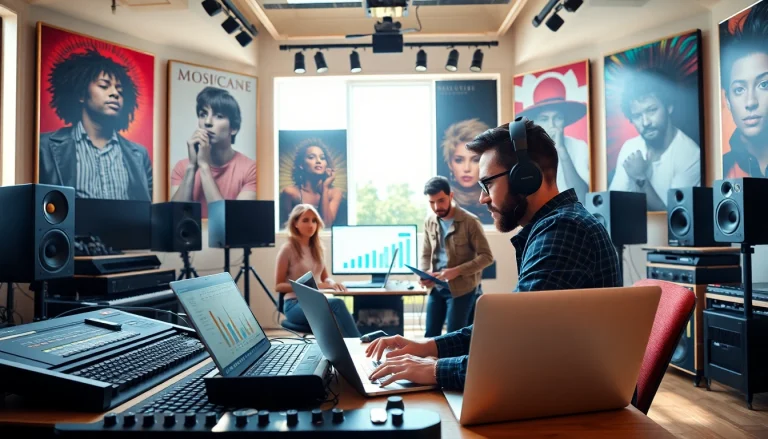
The Fundamentals of Music Pitching
Understanding Music Pitching
Music pitching is the art of presenting your songs to various stakeholders in the music industry, such as record labels, playlist curators, and music blogs, with the goal of gaining exposure and ultimately moving your career forward. This process requires a blend of creativity, strategic thinking, and persistence. Success in music pitching can lead to increased visibility, radio play, and opportunities for live performances.
At its core, pitching is about telling a story—your story—and how it connects to your music. It’s an opportunity to share not only the song itself but also your journey as an artist. Developing a clear understanding of your music and how it fits within the current industry landscape is essential to crafting a compelling pitch. For more insights on effectively music pitching, continue reading.
The Importance of Target Audience
Identifying your target audience is one of the most critical aspects of the music pitching process. Understanding who resonates with your music allows you to customize your pitch for the right recipients. Whether aiming for popular playlists, niche blogs, or local radio stations, each platform has a unique demographic that you need to consider.
It’s also important to analyze the behavior and preferences of your target audience. Conduct surveys, attend industry meetups, and engage with fans on social media platforms to gather insights. Tools such as Google Analytics and social media insights can also provide valuable data regarding audience demographics, interests, and engagement rates. The better you know your audience, the more effectively you can communicate why your song should be featured on their platforms.
Crafting the Perfect Pitch
A successful pitch is not just about sending out your music; it’s about how you present it. A well-crafted pitch includes several key elements that grab attention and communicate your message effectively:
- Subject Line: This is the first thing recipients will see. Make it catchy but relevant to your music.
- Introduction: Briefly introduce yourself and establish credibility. Mention any accolades, previous successful releases, or notable collaborations.
- Song Description: Provide a brief overview of the song, including its background, inspiration, and unique selling points.
- Links: Include a link to the song and your social media platforms for easy access.
- Closing: Conclude with a polite thank you and express your hope to collaborate.
The overall tone of your pitch should reflect your personality while remaining professional. Research shows that personal touches and authenticity can lead to a stronger connection with the recipient.
Researching Your Targets
Identifying Key Curators and Influencers
The first step in researching potential targets is identifying who the key players are. This could include playlist curators, music bloggers, radio show hosts, and influencers in your genre. Use platforms like Spotify, Bandcamp, and SoundCloud to discover relevant playlists and the curators behind them.
Networking tools like LinkedIn can also be useful for finding music industry professionals. Don’t hesitate to reach out to these individuals to introduce yourself and establish a relationship. Creating lists of potential targets along with their contact information and submission guidelines can streamline your pitching process.
Utilizing Social Media for Insights
Social media is an invaluable resource in the music industry, especially for discovering trends and gauging audience reactions. Follow relevant hashtags on platforms like Twitter and Instagram to stay updated on what curators and blogs are currently featuring. Engage with their content and participate in discussions to foster relationships before pitching your music.
Additionally, tools such as Hootsuite and BuzzSumo can help track mentions of your music and identify who is sharing it. By understanding what’s currently resonating with audiences, you can tailor your pitch to align with these interests.
Analyzing Competitor Strategies
Take a close look at other artists in your genre who are successfully gaining traction. Analyze their pitches, the platforms they use, and how they connect with their audience. Tools like SEMrush and Ahrefs can provide data on the organic search traffic of competitor websites, which can help you determine the effectiveness of their promotional strategies.
Competitor analysis isn’t just about imitation; it’s about identifying gaps you can fill. If other artists are not addressing specific themes or fresh sounds, this could be an opportunity for you to present your music as a unique alternative.
Crafting Your Proposal
Elements of a Compelling Music Pitch
A compelling music pitch should not only convey essential information but also evoke emotions. Start by crafting a captivating narrative around your music. What makes your song unique? Whether it’s an innovative sound or a deeply personal story, make sure to highlight these aspects.
Utilize visual elements where possible. Consider creating a one-page press kit that includes high-quality images, notable quotes, and even snippets of past press coverage. These elements can help the recipient visualize your brand and give them a deeper understanding of who you are as an artist.
Personalization Techniques
One of the most critical techniques in music pitching is personalization. Before sending out your pitches, take the time to tailor them to each recipient, referencing specific works they’ve previously featured or acknowledging any interaction you may have had with them in the past.
Personalized pitches show that you value the curator’s time and content, and that you’re genuinely interested in getting your music on their platform. This approach can significantly enhance your chances of getting a positive response.
Common Mistakes to Avoid
Even minor errors can detract from your pitch’s effectiveness. Here are some common pitfalls to watch out for:
- Generic Messaging: Avoid sending the same pitch to multiple targets without tailoring it to fit each one.
- Excessive Length: Keep your pitch concise and to the point to maintain the curator’s interest.
- Ignoring Guidelines: Always adhere to submission guidelines specified by the curators or platforms.
Avoiding these mistakes not only shows professionalism but also enhances the chances of your music receiving the attention it deserves.
Follow-Up Strategies
The Right Timing for Follow-Ups
After sending out your pitch, it’s critical to have a follow-up strategy in place. Timing is key; follow up too early, and it may come off as impatient, while waiting too long may lead to being forgotten. A general rule of thumb is to wait at least one week before following up with a polite email.
Your follow-up should reference your initial pitch to jog their memory. Consider including any new achievements or updates that may add additional value to your pitch, such as a recent performance or positive reviews.
Building Long-Term Relationships
Follow-ups can also serve as an opportunity to build lasting relationships with curators and influencers. Be sincere in your communication; express genuine appreciation for their work and share how you believe your music fits within their platform.
Engaging even when you’re not pitching—by sharing their posts, showing appreciation for their insights, or just sending a check-in note—can help solidify a relationship. These curators may then think of you when new opportunities arise.
Feedback and Learning for Future Pitches
Regardless of the response, feedback is a gift. If a curator declines your pitch, it can be advantageous to follow up politely and ask for any insights they might be willing to share regarding your composition or presentation.
Continually refining your pitching strategy based on this feedback can create a strong learning loop, allowing you to improve and adapt your subsequent pitches for better results.
Measuring Your Success in Music Pitching
Key Performance Indicators (KPIs)
To truly gauge the success of your music pitching efforts, you should define what success looks like. Common Key Performance Indicators (KPIs) in music pitching include:
- Engagement Rates: Measure how many curators responded to your pitch and the nature of those responses.
- Playlist Additions: Track how many playlists your songs get added to as a direct result of your pitching.
- Social Media Growth: Monitor increases in social media followers, likes, and shares following your pitching efforts.
These metrics serve as benchmarks to validate the effectiveness of your strategies and highlight areas for improvement.
Using Analytics Tools
Leverage analytics tools to delve deeper into your performance. Platforms like Spotify for Artists provide insights on listener demographics, song performance, and engagement trends, allowing you to adjust your music and pitching strategies accordingly.
Similarly, Google Analytics can be beneficial if you have a personal website, as it can track visitor behavior and engagement levels, offering a comprehensive overview of how your pitches resonate with the audience.
Adapting Strategies Based on Feedback
Finally, adapting your tactics based on insights and feedback is vital. This flexibility ensures that your pitching strategies evolve alongside shifting trends and audience preferences. Constantly seek to refine your approach, whether that means modifying your pitch language, targeting different curators, or trying out new visual assets.






